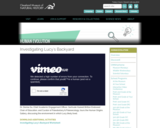
Very good introduction to the biology of these little creatures. Includes good pictures and nice background information.
- Subject:
- Science
- Material Type:
- Reading
- Provider:
- University of California Berkeley
- Date Added:
- 08/28/2023

Very good introduction to the biology of these little creatures. Includes good pictures and nice background information.

In this lab, students will observe and compare fossils with living organisms.

In this Museum Mondays episode from the Cleveland Museum of Natural History, Dr. Denise Su, Chief Academic Engagement Officer, Gertrude Haskell Britton Endowed Chair of Education, and Curator of Paleobotany & Paleoecology, tours the Human Origins Gallery, discussing the environment in which Lucy likely lived. Features a video and downloadable worksheet.

Could a Tyrannosaurus be created in a modern-day lab? Join paleontologist, Jack Horner, in using protein sequencing to find the closest relative to the T-Rex, and then hypothetically re-creating a specimen in the lab.

This article highlights children's literature about fossils, dinosaurs, archaeology, and paleontology for use in the elementary classroom.

This is a very good introduction to the role evolution plays in the development of biodiversity. These topics and extinction are explained with the use of colorful interactive pictures.

This activity is a combination outdoor/indoor lab where students will collect natural materials from the environment and use them to create both a mold and cast model of a fossil. Students will learn how a fossil is formed and why scientists use models to help them understand how things work and develop.

Meet Lupe, a young mammoth who lived during the Ice Age, and learn all about her existence during that time period. Take a virtual trip to the actual mammoth dig site in San Jose and see what the scientists discovered.

This lesson is a classroom activity where students learn about paleontologist Mary Anning, briefly learn about sedimentary rock, and complete observation drawings of Platteville Limestone fossils.

Watch this great video from NOVA online or read the transcript about the many dinosaur species and hundreds of specimens paleontologists discovered buried in the Arctic permafrost. One of their methods of excavation was novel, and not the way most dinosaur bones are dug up. [52:23]

In this lesson, students learn about the earth's past by studying clues that have been left behind, such as fossils and rocks. Students will find the answers to many questions: What is paleontology?, What is geological time?, What can we learn from fossils?, and Where do you find fossils? For the final activity, students pretend they are the paleontologist searching for evidence as to why the dinosaurs went extinct.

A great beginner's guide to examining the nature of science. Covers the basics of how science helps us to understand the surrounding world.

A 14-year-old boy found the fossils of a brand new species of dinosaur--the Bambiraptor. Find out the fun facts about what scientists have discovered about the Bambiraptor and how closely it was related to birds with this resource.

Visit the virtual exhibits at this site to learn more about paleontology, the history of the earth, and life on earth. Use the information on this site to understand geology, geologic time, evolution, and phylogeny.

An excellent overview of the Paleozoic Era. It also provides a chart where you can learn information regarding each of the time frames within the era.

This English language site focuses on the paleontology, geology, and the fossilized flora, and fauna Jordan. Scientific articles are interspersed with extensive photographs and descriptions of various features.


A basic description of the driving force behind plate movement. Describes major features of the ocean floor including mid-oceanic ridges.

An learning activity to help students grasp the concept of relative dating and geologic time.

The scientific fields of paleontology, embryology, anatomy, and genetics have all contributed to a new view of the evolution of the animal kingdom. [3:42]